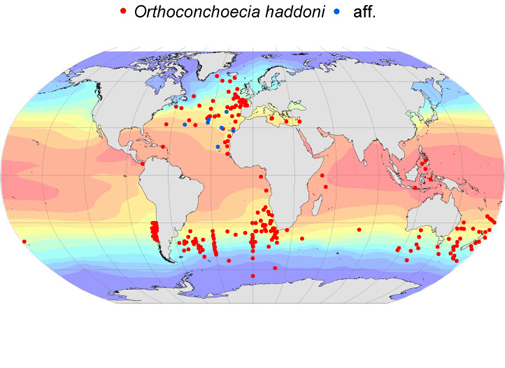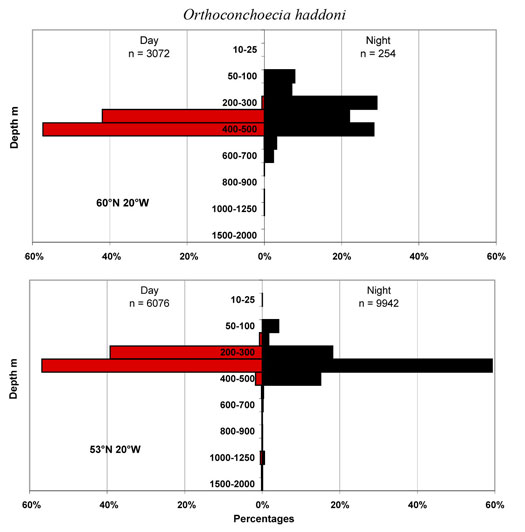Notes
541 records plus 75 (southern race) plus 65 (subspecies marchilensis)
This species was first described from 53°N, 60 nautical miles from Achill Head off the coast of Ireland. Müller (1906) reported it from between 24°N and 40°S, classifying it in his ‘bispinosa group’ of species. He noted there was a ‘northern’ race (♀ 2.6mm and ♂ 1.9mm) which was somewhat smaller than what he considered to be the typical ‘southern’ race (♀ 2.6-2.95mm and ♂ 2.2-2.5mm). However, this is confusing since his northern race came from well south of the type locality in the Northeast Atlantic, and the ‘southern race’ came from the Southern Hemisphere. Poulsen reclassified it in Orthoconchoecia, a genus originally proposed by Granata and Caporiacco (1949). Angel (1971) retained it as a Conchoecia species when he re-described the smaller race, from samples collected off the Canary Islands; unfortunately he termed it ‘Southern form’ to distinguish from the typical larger form described originally by Brady and Norman (NB the typical size is shown by the size data given in the table for specimens from 44°N). This species’s overall latitudinal range stretches from 63°N to 64°S, but the majority (and probably all of them) of the records from between 32°N to 20°S are of the smaller race. The small race is certainly very abundant in the cool waters associated with the Northwest African upwelling region, and extends as far west as 35°W associated with the Azores Current. The species is also common in the Benguela Current upwelling region. Another subspecies haddoni marchilensis was reported by Martens (1979) in the Humboldt Current upwelling region off the coast of Chile. Thus is seems possible that the high latitude forms in both the north and the south are different, and that there are other subspecies or even sibling species associated with the main coastal upwelling centres. Kornicker (1968) reported some very large specimens (♀s 3.5 and 3.9mm long) in a trawl that hit the seabed at a depth of 1000m at 28°N 87°W. Some samples collected recently from the northwest Atlantic contained similarly large specimens (see table); the status of these specimens will need to be investigated. Séguin (1968) also reported it off Malta in the Mediterranean. It is also reported as occurring off Japan. A consistent feature of all these different races is that the males are ~80% smaller than the females. The various forms of this mesopelagic species are potentially useful as indicators and should be critically re-examined. The bathymetric profiles show that this is a mesopelagic species that is most abundant at depths of 200-400m by day and a small proportion of the population migrates up to within100m of the surface. However, the profiles at that time of day were entirely made up of juvenile instars, and adult may have rather different depth distributions.
| 44°N
|
n
|
Mean mm
|
s.d.
|
Range mm
|
|---|
| Female
|
111
|
2.75
|
0.079
|
(2.28) 2.54-2.98
|
|---|
| Male
|
169
|
2.23
|
0.059
|
2.12-2.36
|
|---|
| A-1
|
1274
|
1.71
|
0.072
|
1.54-1.94
|
|---|
| A-2
| 2790
|
1.10
|
0.043
|
0.98-1.22
|
|---|
| A-3
|
2373
|
0.73
|
0.037
|
0.56-0.94
|
|---|
| Azores Front
|
n
|
Mean mm
|
s.d.
|
Range mm
|
|---|
| Female
|
41
|
2.85
|
0.095
|
2.56-3.00
|
|---|
| Male
|
7
|
2.34
|
0.088
|
2.24-2.48
|
|---|
| A-1
|
6
|
1.82
|
0.092
|
1.72-1.96
|
|---|
| A-2
|
|
|
|
|
|---|
| A-3
|
2
|
|
|
0.64-0.72
|
|---|
| Southern O.
|
n
|
Mean mm
|
s.d.
|
Range mm
|
|---|
| Female
|
191
|
2.93
|
0.098
|
2.52-3.16
|
|---|
| Male
|
180
|
2.48
|
0.067
|
2.32-2.64
|
|---|
| A-1
|
8
|
1.87
|
0.078
|
1.76-1.94
|
|---|
| A-2
|
7
|
1.17
|
0.044
|
1.10-1.24
|
|---|
| A-3
|
1
|
|
|
0.84
|
|---|
| NW Atlantic
|
n
|
Mean mm
|
s.d.
|
Range mm
|
|---|
| Female
|
19
|
3.55
|
0.103
|
3.36-3.72
|
|---|
| Male
|
17
|
3.57
|
0.072
|
3.44-3.68
|
|---|
| A-1
|
11
|
1.87
|
0.078
|
1.76-1.94
|
|---|
| A-2
|
7
|
1.17
|
0.044
|
1.10-1.24
|
|---|
| A-3
|
1
|
|
|
0.84
|
|---|





